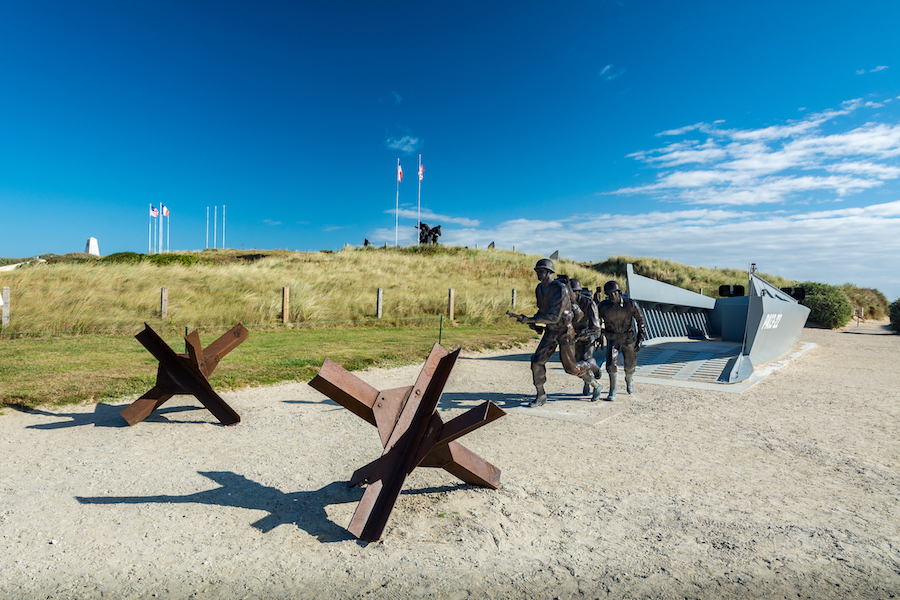Poignant and precious: How to live out the nation’s greatest story for D-Day 75
This year marks the 75th anniversary of perhaps the most important day in modern British history: D-Day.
It is difficult to imagine the sheer scale and human expense of the operation that would eventually turn the tide of the war in Western Europe, though we are surrounded with poignant and precious artefacts – both in Britain and in France – that are not only easy to discover, but truly bring to life the story of June 6, 1944.
This 75th anniversary offers the perfect opportunity to discover the story of D-Day first-hand, and here’s how to do it over five days, split between both sides of the Channel.
Day One: IWM Duxford and the American Air Museum, Duxford
View this post on Instagram
One hour north of London, this historic airfield was in use during World War I but earned its wings, so to speak, when it became the base for the 82nd, 83rd and 84th US air squadrons in World War II. Today, all but one of its original hangars still stand – the one missing was blown up during filming for Gus Hamilton’s Battle of Britain film.
While the site is quiet, almost tranquil today, in the early hours of June 6, 1944, it would have been alive with the roars of engines, with gliders and bombers taking off in a seemingly endless stream. Many of the aircraft that flew from Duxford can now be seen inside the American Air Museum, built on the site in 1997.
To make your visit to IWM Duxford truly special, look out for the Daks Over Duxford event on June 4-5 to get a glimpse of what the skies over Normandy might have looked like 75 years ago.
How: Tickets for IWM Duxford cost from £18 (£20 on the day) and include entry to the American Air Museum, Historic Duxford and the Airborne Assault Museum. Visit iwm.org.uk/visits/iwm-duxford.
Day Two: HMS Belfast and Churchill War Rooms, London
The battle may have been fought in Normandy, but it was orchestrated from Winston Churchill’s command centre beneath Whitehall, which has been delicately preserved and transformed into an IWM museum.
With a guided tour, you’ll have the chance to pace the corridors and explore the rooms from which Churchill and his staff sent their orders to the front. You can tour everything from the conference room, to Churchill’s bedroom and, my personal favourite, the Map Room. Note the pinholes still left in the wall – every one of them tells a story.
Notoriously reckless, it was only thanks to King George VI’s intervention that Winston Churchill didn’t hop aboard HMS Belfast and join the D-Day assault himself. But you can live out his fantasy today, by exploring this marvellous battleship moored outside London Bridge Station, dipping and diving in and out of the bridge, the engine room, the crew’s quarters, even the six-inch cannons – which, on D-Day, fired around 4,000 shells at a rate of 96 per minute.
How: Tickets for HMS Belfast start from £16.20 (£18 on the day). See iwm.org.uk/visits/hms-belfast. Tickets for Churchill War Rooms start from £22. See iwm.org.uk/visits/churchill-war-rooms.
Day Three: Mémorial Pegasus Museum and the Caen Memorial, Normandy

Travel in comfort on an overnight ferry from Portsmouth to Caen, a journey not dissimilar to the one the landing craft would have taken on the morning of June 6, 1944. But while today it’s possible to book a bedroom with en-suite bathroom (from just £85; brittany-ferries.co.uk), the soldiers at that time would have barely had space to stand amongst the equipment they had to carry. The seas on the night of June 6 were notoriously choppy – so you can imagine the soldiers wouldn’t have had much sleep.
Make your first destination in Normandy Mémorial Pegasus, home of the original Pegasus Bridge. Allied paratroopers fought a bloody battle in the middle of the night to capture this crucial crossing over the River Orne and Caen Canal. The bridge itself is riddled with bullet holes from that fateful night.
View this post on InstagramMémorial de la paix 🕆 #Débarquement #Normandie #Soldats #paix
From here, move on to the Caen Memorial Museum. It is easy to forget that D-Day was only the first day in the month-and-a-half-long Battle of Normandy, a battle which would result in the almost total destruction of Caen. This striking museum walks visitors through the background to the war, culminating in an exhibition that conveys the immense sacrifice made by the citizens of Caen.
How: Tickets for Mémorial Pegasus Museum start from €8/£7. Visit musee.memorial-pegasus.com/fr. Tickets for Caen Memorial Museum start from €19.80/£17. Visit normandy.memorial-caen.com.
Day Four: Bayeux War Cemetery, Bayeux

As a hospital city, Bayeux managed to avoid heavy bombing and fighting. Today, it is home to the largest World War II Commonwealth cemetery, which features the graves of British, Canadian, Australian, New Zealand, Polish, South African, Russian, French, Czech and German troops. Immaculately maintained and overlooked by the stunning Bayeux Memorial, this is an important destination for anyone wishing to understand the cost of our peace.
Of course, 900 years before D-Day, another great battle helped to shape the course of British history, and its 70m-long hand-woven record is synonymous with the town of Bayeux. So, while you are here, take the opportunity to enjoy a 25-minute-long audio tour of the Bayeux Tapestry Museum – a salient distraction.
How: Tickets to the Bayeux Museum from €9.50/£8. Visit bayeuxmuseum.com/en/the-bayeux-tapestry.
Day Five: The German Battery and Arromanches-les-Baines, Longues-sur-Mer

Scars of the war are dotted all over Normandy, but none are quite as well preserved as this stretch of the Atlantic Wall, Hitler’s so-called impenetrable coastal barrier, which ran from Norway to the border of Spain. The first thing you’ll notice about these concrete pillboxes is the ingenuity of their design – their two-metre-thick walls of reinforced concrete made them virtually bomb-proof. That, plus of course the gigantic guns, still standing, which were capable of firing a 45kg shell up to 20km once every 10 seconds.

Just down the road, finish your tour at Arromanches-les-Bains. This quiet fishing village became the site of the British Mulberry harbour, from which millions of tonnes of supplies poured into France, sustaining the Allies’ invasion. The sheer scale of this operation comes alive in Arromanches’ beautiful Musée du Débarquement, where visitors can see scale models of the Mulberry harbour, while also gazing out to sea to glimpse the decaying remnants still there to this day.
How: Tickets from €8.20/£7. Visit musee-arromanches.fr.
For more information about D-Day in Normandy, visit normandydday75.com.
The Press Association
Latest posts by The Press Association (see all)
- How to attract more bees to your garden - May 3, 2024
- The costly insurance pitfalls to avoid when kitting out your garden this summer - May 3, 2024
- Gavin And Stacey’s best moments: From Smithy’s Indian takeaway to Pam eating ham - May 3, 2024
- Princess Charlotte ‘s ninth birthday marked by picture release - May 2, 2024
- Strong passwords more important than ever, experts warn - May 2, 2024





















